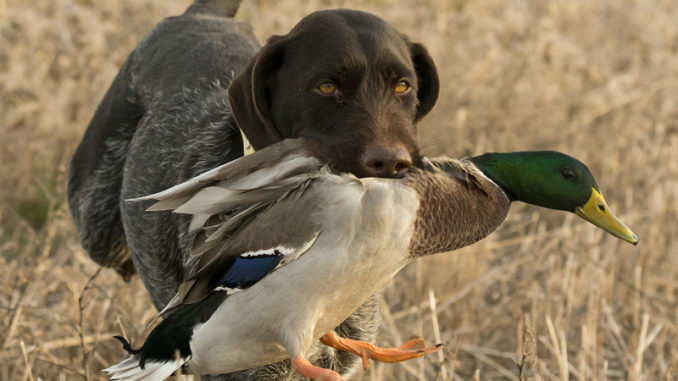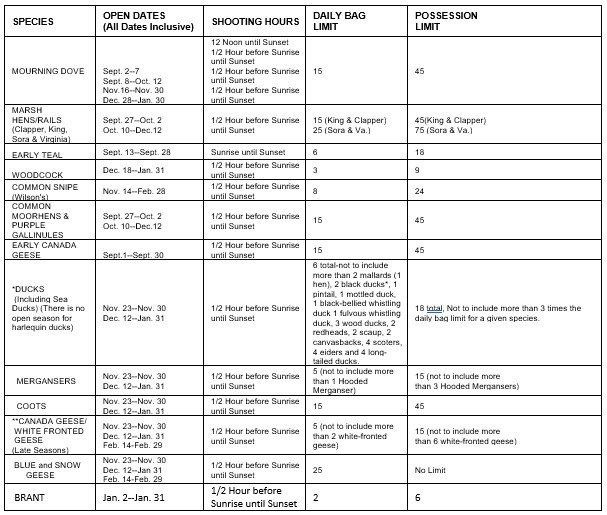
Upcoming season has some notable changes in bag limitsThe seasons and regulations for migratory waterfowl hunting in South Carolina have been approved. The S.C. Department of Natural Resources Board, the policy-making body of the S.C. Department of Natural Resources (SCDNR) sets seasons and bag limits for waterfowl and other migratory game birds. They are approved annually based on a framework set by the U.S. Fish and Wildlife Service (USFWS). Among the most notable changes for the upcoming 2019-2020 season, is the reduction in the daily bag limit for mallards from 4 to 2 birds (only one (1) of which can be a hen). The reduction is a carefully considered response to a long-term decline in the population of Northeast mallards (those that breed and winter in the Atlantic Flyway), says SCDNR Biologist Molly Kneece. Kneece is a waterfowl manager who represents the Department on the Atlantic Flyway Council Technical Section. Mallard populations in other flyways are in good shape. In other changes, the daily bag limit for Northern pintails has also been reduced this season to 1 bird. The bag limit for black ducks remains at 2. However, only 1 black or mottled duck per day may be harvested in areas east of Interstate 95. All waterfowl hunters should also take note that there is NO open season for tundra swans in South Carolina. What’s the outlook for the upcoming season?As far as the outlook for the 2019-2020 season goes, at least one indicator is pointing in the right direction. “The Atlantic Flyway Breeding Waterfowl Plot Survey showed average to good nesting effort for ducks this year,” said Kneece. “But to quote my predecessor [long-time SCDNR Waterfowl Project Coordinator Dean Harrigal]. ‘To have ducks you need three things—food, water, and weather.’ “ SCDNR biologists and technicians are working hard on the first part of that equation. Managed wetlands on the Palmetto State’s Category I and Category II Waterfowl Areas, as well as our abundant lakes, rivers and tens-of-thousands of privately-owned and managed waterfowl habitat supply the second. “We are producing abundant food on our waterfowl WMAs across the state,” said Kneece. “Our biologists and managers continue work toward setting the table for migratory waterfowl this winter. (We) are hopeful for some forgiving fall weather. The number of migrating waterfowl that show up in South Carolina during the winter largely depends on winter weather conditions. Cold, snow, or extremely dry conditions to the north and west can mean good numbers of waterfowl in our state. We’re hopeful to see the right combination of fall and winter weather to push waterfowl to South Carolina during the 2019-2020 season.” Regulations and information available at SCDNR’s websiteUpdated information and details about the 2019-2020 waterfowl seasons is available now on the SCDNR website. Paper copies of the 2019-2020 version of “South Carolina Hunting & Fishing; The Official State Regulation Guide” (aka the “Rules & Regs” Booklet) will be distributed to retail stores that sell hunting and fishing licenses over the coming weeks. Electronic versions of the updated Regulation Guides are available now on the SCDNR website [www.dnr.sc.gov] in both PDF and mobile device-friendly formats. Basic species seasons, open dates, shooting hours and daily bag limits are included below. 2019-2020 Season Dates and Bag Limits:*Black ducks/mottled ducks, the limit is as follows:For areas east of I-95, one black duck or one mottled duck in the total bag of no more than six. For areas west of I-95, two black ducks or one black duck and one mottled duck in the total bag of no more than six. **Canada Goose Hunting Area:During the September 1—September 30 segment hunting for Canada Geese is allowed statewide. During the remaining three segments, the hunting area excludes that portion of Clarendon County bounded to the north by S-14-25; to the east by Hwy 260; and to the south by the markers delineating the channel of the Santee River. It also excludes that portion of Clarendon County bounded on the north by S-14-26 and extending southward to that portion of Orangeburg County bordered by Hwy #6. State Youth Day, Nov. 16, 2019 (Legal Species: Ducks, mergansers, coots.):Only youth who are 17 years of age or younger may hunt. They must be accompanied by an adult of at least 21 years of age who is fully licensed. Youth who are 16 and 17 years of age, who hunt on this day, must possess a valid South Carolina hunting license and Migratory Bird Permit and a valid Federal Waterfowl Stamp. Daily and possession bag limits are the same as shown above. Federal Youth Days, Feb. 1 and Feb. 8, 2020 (Legal Species: Ducks, geese, mergansers, coots, moorhens, gallinules.):Only hunters 17 or younger may hunt on these days. They must be accompanied by a person at least 18 years of age. Youth who are 16 and 17 years of age, who hunt on these days, must possess a valid South Carolina hunting license and Migratory Bird Permit and a valid Federal Waterfowl Stamp. Daily and possession bag limits are the same as shown above. Sea Duck Area and Duck Limits Within this Area:The sea duck area is the Atlantic Ocean waters separated from any shore, island or emergent vegetation by at least one mile of open water. In this area, the sea duck limit is 5 with no more than 4 scoters, 4 eiders or 4 long-tailed ducks. In addition and within this area, a hunter may take up to 6 other ducks as described for the rest of the state but not including sea ducks. The shooting of crippled waterfowl from a vessel under motor power in the sea duck area is allowed. Extended Falconry Season:Falconry is a permitted means of taking ducks, coots and mergansers in South Carolina. The extended season for falconry shall be Nov. 4, 2019 through Nov. 22, 2019 and Dec. 1, 2019 through Dec. 11, 2019. Daily bag and possession limits for these birds shall not exceed 3 and 9 birds, respectively, singly or in the aggregate. Statewide hunting hours shall be one-half hour before sunrise to sunset. Click here to read about some new public hunting opportunities on private lands. |

